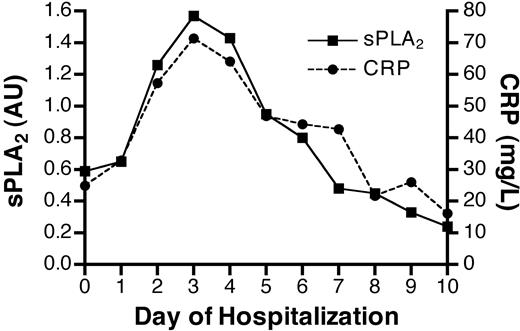Previous studies from our institution have shown that serum secretory phospholipase A2 (sPLA2) levels are markedly increased in sickle cell disease (SCD) patients with acute chest syndrome (ACS)1 and that sequential measurements of sPLA2 are useful in predicting the subsequent development of ACS in patients hospitalized for vasoocclusive crisis (VOC).2 However, sPLA2 assays are not widely available in clinical laboratories. Thus, we sought a surrogate marker that might be measured instead of sPLA2. Because sPLA2 is an acute-phase protein,3 we hypothesized that serum concentrations of another acute-phase reactant, C-reactive protein (CRP), might change in concert with sPLA2. CRP and sPLA2 have been shown to correlate well in patients with septic fever.4,5 In addition, CRP values are comparable whether measured in serum or plasma, after delayed sample processing or prolonged storage, or after up to 7 freeze-thaw cycles.6
We performed assays for sPLA2 and CRP on 139 serum samples from 20 hospitalized SCD patients; 13 patients had VOC and 7 had ACS. Between 5 and 10 serum samples collected during the course of hospitalization were analyzed for each patient. Serum samples were assayed for sPLA2 on the day of collection, prior to freezing. Enzyme activity was determined with a fluorometric assay7 and expressed as arbitrary units (AU), where 1 AU was the activity associated with a serum immunoreactive sPLA2 concentration of 100 ng/mL.7 CRP concentrations were measured with an in-house sandwich enzyme-linked immunosorbent assay (ELISA). To validate the assay, we measured CRP levels in serum obtained from 17 healthy individuals. Serum CRP (mean ± SEM) for this group of donors was 0.81 ± 0.26 mg/L. This concentration is similar to previously published CRP values for healthy donors.6,8
Daily mean serum CRP concentrations and sPLA2 activity during 10 days of hospitalization are shown in Figure 1 and Table 1. Mean CRP values paralleled changes in sPLA2 very closely for the first 5 days of hospitalization, after which they decreased somewhat more slowly than did sPLA2. Examination of plots from individual patients showed that the day of peak CRP concentration coincided with the day of peak sPLA2 concentration in 9 cases, was one day earlier in 5 instances, and one day later in 5 instances. Thus, based on the pattern of changes in concentration, CRP appeared to be a good surrogate for sPLA2.
Day-by-day comparison of mean sPLA2 and CRP values in SCD patients with VOC or ACS. Mean serum sPLA2 activity (AU) and immunoreactive CRP values (mg/L) are shown on a day-by-day basis for 139 serum specimens. Numeric data for each day of hospitalization are shown in Table 1, with mean and SEM sPLA2 and CRP values for the indicated number (N) of serum specimens.
Day-by-day comparison of mean sPLA2 and CRP values in SCD patients with VOC or ACS. Mean serum sPLA2 activity (AU) and immunoreactive CRP values (mg/L) are shown on a day-by-day basis for 139 serum specimens. Numeric data for each day of hospitalization are shown in Table 1, with mean and SEM sPLA2 and CRP values for the indicated number (N) of serum specimens.
Numerical data for results shown inFigure 1
Day . | 0 . | 1 . | 2 . | 3 . | 4 . | 5 . | 6 . | 7 . | 8 . | 9 . | 10 . |
|---|---|---|---|---|---|---|---|---|---|---|---|
| N | 18 | 16 | 17 | 17 | 18 | 13 | 13 | 10 | 8 | 6 | 3 |
| sPLA2 mean | 0.59 | 0.65 | 1.26 | 1.57 | 1.43 | 0.95 | 0.80 | 0.48 | 0.45 | 0.33 | 0.24 |
| sPLA2 SEM | 0.13 | 0.14 | 0.30 | 0.44 | 0.62 | 0.48 | 0.20 | 0.11 | 0.12 | 0.07 | 0.05 |
| CRP mean | 24.91 | 32.87 | 57.31 | 71.42 | 64.13 | 46.85 | 44.30 | 42.69 | 21.65 | 26.02 | 16.14 |
| CRP SEM | 10.16 | 12.60 | 21.03 | 19.40 | 18.44 | 13.92 | 15.47 | 16.04 | 9.13 | 9.63 | 9.38 |
Day . | 0 . | 1 . | 2 . | 3 . | 4 . | 5 . | 6 . | 7 . | 8 . | 9 . | 10 . |
|---|---|---|---|---|---|---|---|---|---|---|---|
| N | 18 | 16 | 17 | 17 | 18 | 13 | 13 | 10 | 8 | 6 | 3 |
| sPLA2 mean | 0.59 | 0.65 | 1.26 | 1.57 | 1.43 | 0.95 | 0.80 | 0.48 | 0.45 | 0.33 | 0.24 |
| sPLA2 SEM | 0.13 | 0.14 | 0.30 | 0.44 | 0.62 | 0.48 | 0.20 | 0.11 | 0.12 | 0.07 | 0.05 |
| CRP mean | 24.91 | 32.87 | 57.31 | 71.42 | 64.13 | 46.85 | 44.30 | 42.69 | 21.65 | 26.02 | 16.14 |
| CRP SEM | 10.16 | 12.60 | 21.03 | 19.40 | 18.44 | 13.92 | 15.47 | 16.04 | 9.13 | 9.63 | 9.38 |
In this analysis, we wished only to determine whether CRP could serve as a suitable substitute for sPLA2 in serum samples from SCD patients, and our sole criterion for selecting patients was the availability of several daily serum samples for assay. Therefore, we can draw no conclusions regarding the ability of CRP to predict the likelihood that ACS will develop after hospitalization with VOC. However, changes over time in CRP closely paralleled changes in sPLA2, and values for the 2 analytes were correlated (Spearman rank correlation coefficient = 0.641; P < .0001; data not shown). Overall, these results suggest that further studies should be performed to determine whether CRP could be used as an alternative to sPLA2 to predict the development of ACS in VOC patients.
Supported by National Institutes of Health grants HL20985 and M01-RR0127 (Pediatric Clinical Research Center)


This feature is available to Subscribers Only
Sign In or Create an Account Close Modal